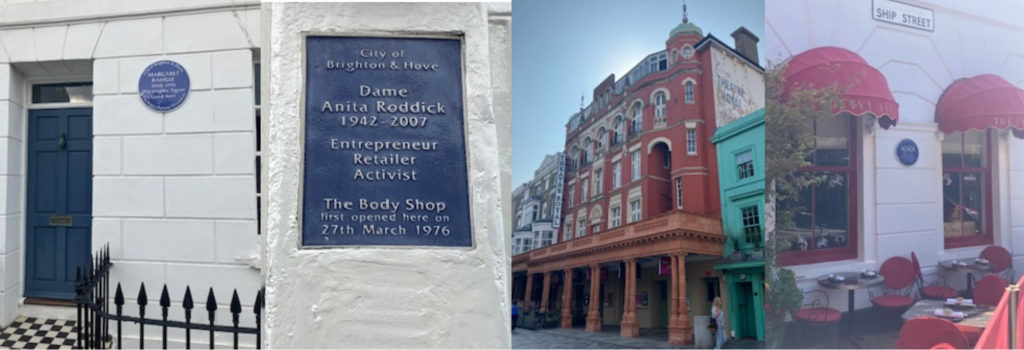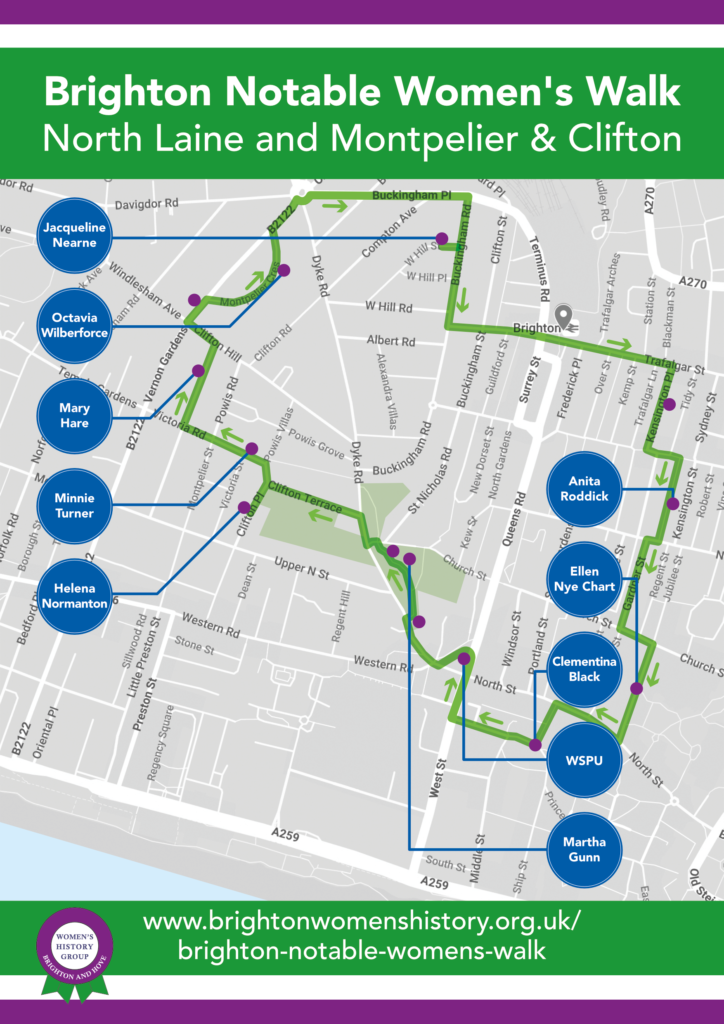SUMMARY
This walk celebrates a wide range of Brighton women from the theatrical, medical and legal professions, businesswomen, campaigners and reformers, and a secret agent. Many were involved in the fight for women’s rights, and the walk features four plaques commemorating the centenary of the first extension of women’s suffrage in 1918. It winds through two fascinating and contrasting conservation areas of central Brighton, which developed in different ways during the nineteenth century. It starts in North Laine, historically a residential quarter for the artisans who served the gentry in the Lanes, and the foundries, abattoirs, printers and workshops of the traders who supplied them. After dipping briefly into the Lanes, the trail continues past the Clocktower up to the leafy streets and creamy Victorian villas of Montpelier and Clifton. On the way you follow the historic route of Dyke Road coming in from the South Downs, past St Nicholas, Brighton’s original parish church and its green spaces.
The circular walk starts and ends at Brighton station and takes around an hour and a half. It is relatively level for the first part in North Laine, then a stint uphill to reach Montpelier and Clifton. This walk has been devised and based on research by members of the Brighton and Hove Women’s History Group, whose mission is to raise awareness of the contribution women have made to the city’s history.
THE ROUTE

Starting from the Grade II* listed Brighton railway station, enter North Laine via the Trafalgar Street tunnel below the forecourt. Walk down Trafalgar Street and turn into Kensington Place on your right. Number 34 was the home of Margaret ‘Peggy’ Ramsay, (1908-1991), one of the country’s best known theatrical agents, whose clients included Joe Orton, Alan Ayckbourn and David Hare. The plaque was unveiled by the actor Simon Callow, in 2009. Continue down to Gloucester Road and turn left then right into the pedestrianized Kensington Gardens. The street is crammed on both sides with characterful independent shops, which in the 1970’s included the first ‘Body Shop’ at number 22, founded by Anita Roddick (1942-2007), from nearby Littlehampton. As this blue plaque marks a location, it is rectangular rather than round. As well as an entrepreneur and retailer, Dame Anita Roddick was an energetic human rights, social justice and environmental campaigner, who grew a global business and reputation, with 2000 outlets in 55 countries. She was a high-street champion of fair trade and ethical business practices – such as recyclable packaging – which have resonance today.
Cross diagonally to your right into lively Gardner Street, then left and right into New Road, running alongside Pavilion Gardens. Take a moment to enjoy the view from the iconic Café, before turning west to admire the impressive and recently restored front of the Theatre Royal, originally built around 1807. At number 9 – ‘over the shop’ – lived the theatre’s proprietor, Ellen Nye Chart (1839-1892). She was another astute businesswoman who, through her innovative ideas, transformed it into a prosperous enterprise and theatre of national standing. She introduced a year-round programme rather than just the summer season, and attracted stars like Lily Langtry, Sarah Bernhardt and Henry Irving. When she died, her funeral was the largest the town had ever seen, with many hundreds lining the streets to say farewell. BHWHG have successfully campaigned in partnership with the Theatre Royal for a blue plaque in her honour. This will be unveiled on the Theatre frontage in June 2026, to mark the 150th anniversary of the start of her sole management.
Turn right along North Street and across into Ship Street, where on the left outside number 45 there is a plaque to Clementina Black (1853-1922), trade unionist, writer, suffragist and social reformer. She was a tireless, lifelong campaigner for women’s rights, and was the first woman to publicly call for equal pay for equal work. In 1906 she became Secretary of the Women’s Franchise Declaration Committee, organising a petition demanding women’s suffrage which was signed by over a quarter of a million women. Turn right along Duke Street to West Street and right again up to the Clock Tower. On the northwest corner of the Quadrant there is a rectangular blue plaque commemorating the offices of the Women’s Social and Political Union, headquarters of the Brighton women’s suffrage movement.

Walk left up North Street from the Clock Tower and take Dyke Road on your right – the historic route from the city up to the Downs. On your right is the grey frontage of Wykeham Terrace, originally built in 1857 as a ‘Home for Penitent Women’, and now converted into flats for residential use. Dame Flora Robson (1902-1984) is commemorated by a grey plaque at number 7, having lived there from 1976 until her death. She starred in over 100 stage plays and sixty films during her career, her roles including Elizabeth I, Empress Elizabeth and Lady Macbeth, Follow the brick path straight ahead into the leafy churchyard of St Nicolas of Myra, ‘the ancient mother church of Brighton’. If the church is open, there is a further plaque to Dame Flora in the porch, and the church itself is well worth a visit. Outside, see to the right two weathered graves surrounded by railings. The first is for Phoebe Hessel, who reputedly had a full military combative career in the 5th Regiment of Foot for 17 years before being revealed as a female and discharged. She latterly enjoyed a lengthy retirement in Brighton, supported by a generous pension from the Prince Regent, and lived to 108. The next grave commemorates Martha Gunn (1731-1815), a professional ‘dipper’ with a thriving and long-running business on the beach assisting bathers, including the Prince Regent himself, with whom she was a favourite. Her family still has many descendants in Brighton today, some of them running the local florists called Gunns.
Exit the church yard, turning left to continue up Dyke Road, then turn left along the raised pavement of Clifton Terrace, with its creamy seaside villas and southern views. Turn left at the end down Clifton Place, and at number 4 is a plaque to Helena Normanton (1882-1957), the first woman to be accepted to the bar. Her later distinguished legal career saw many ‘firsts’ – first female Counsel in the High Court of Justice and the Old Bailey, first woman to obtain a divorce for her client, first woman to lead the prosecution in a murder trial and one of the first female Kings Counsel. In 1924 she became the first married woman granted a passport in her maiden name. Retrace your steps up Clifton Terrace and turn left into Victoria Road.
At number 13 was a famous boarding house, ‘Seaview’ run by Minnie Turner (1866-1948). This became a refuge for suffragettes recovering from imprisonment, hunger-strikes and forcible feeding under the infamous ‘Cat and Mouse Act’. Arrest and imprisonment failed to break Minnie’s fighting spirit: when hostile local men broke Seaview’s windows in 1913, she hoisted a sign saying ‘Male Logic’. Her guests included WSPU leaders Emmeline Pankhurst and Emily Wilding Davison. Mary Clarke, the first woman to die in the suffrage cause, lived at Sea View for the last 18 months of her life, while running the South East suffrage movement from the WSPU office in Queen’s Road. She was a close friend of Minnie Turner, and they attended the protests on Black Friday (18th November 1910) together, where Mary was injured, and subsequently nursed at Sea View until returning to London, being arrested, imprisoned and dying on Christmas Day, two days after her release.

Further along Victoria Road, turn left into St Michael’s Place.At number 17, Mary Hare (1866-1945) ran a school for deaf children, the precursor of what is now the largest special school for the deaf in the UK. She was a pioneer in this field, with the unique and groundbreaking approach that deafness was a sensory, not a mental, disability and could be overcome with proper instruction. She also set up a uniformed women’s police force to help women and children in some of Brighton’s poorest areas. A blue plaque was unveiled by the Mayor of Brighton & Hove in March 2024.
Walking north up Vernon Terrace, there is a grey plaque at number 6 for Eleanor Marx, writer, translator and activist. Also the daughter of Karl Marx, but the plaque is dedicated to Eleanor in her own right as a campaigner for trade union, women’s and children’s rights.

Turn into the sweep of Montpelier Crescent, and at number 24 pioneering doctor Octavia Wilberforce (1884-1963) lived and worked with her companion, the novelist and actress Elizabeth Robins (1862-1952). The latter, internationally famous in her own right, helped bankroll the national suffrage organisations. She was asked not to join the WSPU because – as an American – she could be deported, and they needed her money and influence to stay in the country. Both women helped develop and fund other women’s health services, were active in fighting for women’s rights, and are jointly commemorated by a blue plaque on what is now – appropriately – the Seven Dials Medical Centre.
Cross Seven Dials into Buckingham Place, and take the third right into Buckingham Road, for one final and intriguing stop. West Hill Street, the first road on your right, is a modest but charming row of terraced Victorian houses. At number 32 a blue plaque commemorates the birthplace of Lieutenant Jacqueline Nearne (1916-1982). Described as a ‘Designer’ on the plaque, it also acknowledges that in WW2 she was a secret agent in France for the Special Operations Executive, codenamed ‘Josette’ and acting as a courier for the Resistance. She was awarded an MBE in England and the Croix de Guerre in France. Post-war, she worked for the United Nations in New York from 1946 until her retirement in 1978. It seems appropriate to end the tour with a lesser-known figure, a reminder of the ‘hidden thread’ which women’s history so often represents.
Turn back to Buckingham Road and continue along it until Gloucester Road on the left brings you full circle back to the station.
THE MAP
